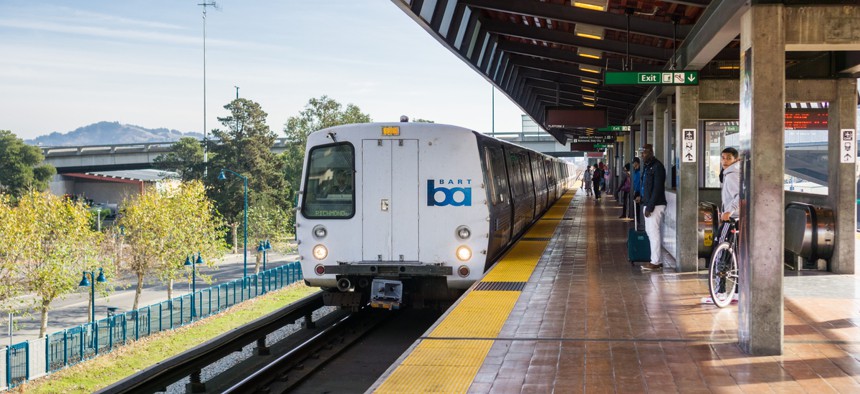How One City Handles Complaints About Its Transit System

A BART train stops in Oakland. Sundry Photography/Shutterstock
San Francisco’s BART System doesn’t just tweet back at people complaining on social media, but also tries to tap into the information to help guide maintenance, cleanup, and repair in real time.
The Bay Area Rapid Transit system, or BART, serves about 420,000 people each day. For a system originally designed decades before the tech boom brought thousands more riders to the region than anticipated, that means there are a lot of problems—and a lot of complaints.
Many riders’ grievances arrive at the agency’s social media doorstep through tweets. That provided an opportunity for BART to be proactive, said Alicia Trost, the transit system’s communication manager.
“We’re taking a risk that not many governments will take, because we answer people’s complaints publicly, with a personal message, instead of going to direct messages or sending them an auto-response,” Trost said.
The fear of responding on social media is justified, in some city’s eyes. Public transit agencies receive some of the most vitriolic wrath that Twitter has to offer. A 2015 study found that four of the nation’s largest transit systems, including San Francisco’s, spurred the most negative sentiments on Twitter, falling near the IRS and rising only slightly above the TSA and Osama bin Laden.
But Trost’s communications team of four hopes to change people’s perceptions of BART’s customer service by monitoring complaints in real time and being transparent about issues the system faces. The team is able to accomplish those goals through a cloud management program that allows them to set alerts for problems flagged by “influencers,” journalists, or elected officials, and to monitor trending topics on a given day.
BART began to build out the agency’s tweet response system in late 2017. The year before, a tweet by the official BART account in reaction to a rider complaint said that much of the system had “reached the end of its useful life.” The tweet added “this is our reality,” a phrase that Twitter users embraced and turned into a viral hashtag, which Trost said helped convince BART executives of the power of social media and the need for greater investment in the platform. “I worked with our CIO to investigate options that would give us better data and allow us to respond to riders in real time. I wanted to find something that would let us use social media like a chat room instead of a bull horn,” Trost said.
Their new social management system, described as a “see-click-fix” operation, launched in 2018. Without adding any additional staff, the BART communications team could now see tweets and photos about problems, elevate tickets to the maintenance staff, and follow-up with riders to thank them for reporting issues. They respond Monday through Friday during the regular workday.
Trost said that people immediately took notice of the change. In 2015, BART received 13,000 mentions on Twitter, but once the system debuted, they had over 60,000. That has changed the communications strategy for the team. “Now, what we talk about on social media is based on topics raised by the public, as opposed to marketing messages we want to push,” Trost said. “We don’t ever reply with ‘We’ll get back to you’ or ‘Here’s a webpage where you can find information.’ Instead, we prioritize trending topics, and now we have more of a partnership with riders.”
The most pressing complaints vary from week to week, but overcrowding, broken escalators and elevators, dirty train cars, parking availability, and delays are frequent sources of frustrations for riders. They also get a lot of tweets that Trost refers to as “do better” issues that show a general discontent with the state of transit in Silicon Valley, where people’s expectations for quick, modern transportation aren’t always satisfied. “In those cases, we have to articulate why our system hasn’t caught up,” Trost said. “It’s on us to recognize where we fall short and drive a conversation about investments in transit systems.”
If enough people complain about a certain issue, BART will change its policies. That’s what happened when BART shifted some weekend cleaners to peak weekday times, which prompted a litany of tweets about dirty train cars by Monday morning riders, so BART reversed course. Complaints can also prompt new features for the BART app. When, in mid-2018, many riders posted pictures of discarded needles from opioid users on the system, Trost said that she used social media data to convince executives that BART needed a strong response. Within a week, the team built a special biohazard reporting process for the BART app and website that pings a rapid response safety crew whenever a complaint is received. “We know that we can’t solve the opioid epidemic, but in the meantime, this is something we can do,” Trost said.
Trost said she hopes that BART’s proactive use of social media makes people realize how important the train system is to the region, and how much BART values being transparent with rider feedback. They hope to soon implement an email program that can target riders based on their county to give them specified service alerts, and one day debut 24/7 social media coverage, as weekends aren’t currently staffed by the communication team. “We want to identify the best ways to communicate with all our riders,” Trost said. “Then we can have a 360 degree understanding of how we can better meet their needs.”
Emma Coleman is the assistant editor for Route Fifty.
NEXT STORY: GSA opens cloud info hub






